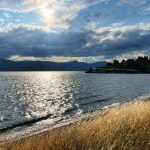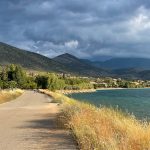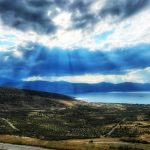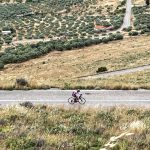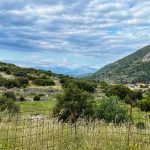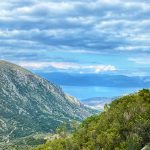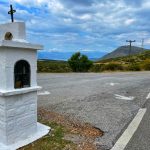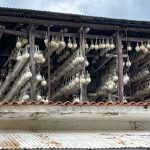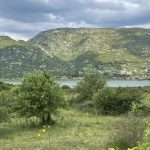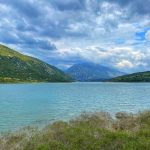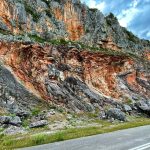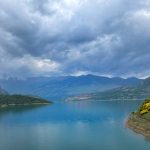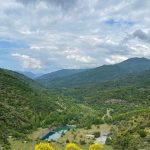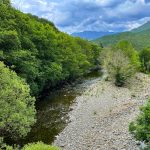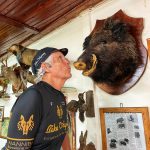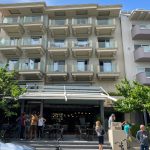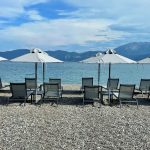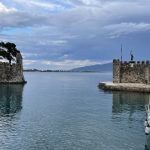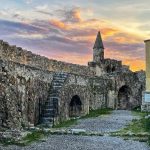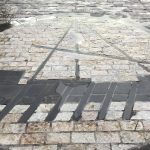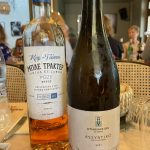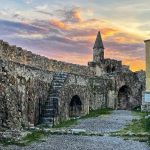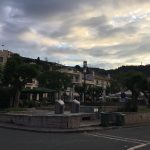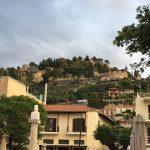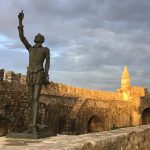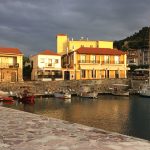DAY 7 – GALAXIDI TO NAFPAKTOS – DISTANCE 100KM / 62MI | ELEVATION 2300M / 7546FT May 28
Supposed to rain in the mountains today, if so it will be the first rain of the trip, we will see.
Another hearty breakfast before bidding adieu to the nice folks at the Ganimede Hotel. 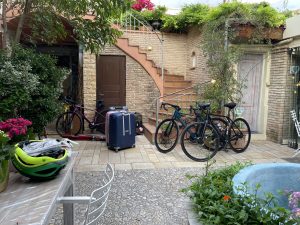
One of the tour’s most challenging days today as we headed into rural Greece. A beautiful quiet and gradual (5%) climb this morning took us up through olive groves away from the Delphic basin.
The spectacular views made me feel as if you are climbing into the sky, as the roads cling to the sides of mountains as we headed into the Dasiko Symplegma Gionas National Park.
As we came over the top we were on a perfect surfaced road (thank you to EU funding!) with views for miles and no cars in sight, and with a 15km descent, we rode alongside Lake Munro, with mountains ranging along its far edge and only the occasional tractor or farm vehicle for company. We were in genuine Greece here – no tourists in sight!
Lunch was at a family run cafe restaurant at the base of our 2nd climb….Greek style cabbage rolls, taziki, roasted goat and tomatoes, Greek salad.
Then following the course of the Mornos Gorge, we took on our second genuine climb of the day (6km @ 6%) before cruising the last 20km all the way back down to the Corinthian gulf. 2km into the climb the skies opened and poured rain until halfway down the descent. That took us to a sunny seaside town of Nafpaktos, far off the beaten track but genuinely one of the most beautiful Venetian harbours you will see.
Dinner at an upscale bistro
And walk along the pebbly beach back to the hotel with some of my mates!

Life is Good in Nafpaktos!

But one last word about Delphi: ODYSSEUS WAS HERE!
The greatest oracle of ancient Greece…Odysseus consulted an Oracle before the Trojan War. The Oracle had told him that if he went to war, he would be away for 20 years and would return a beggar. So Odysseus pretended to be mad and sowed his fields with salt instead of seeds. However, Palamedes, at the behest of Menelaus’ brother Agamemnon, seeked to disprove Odysseus’ madness and placed Telemachus, Odysseus’ infant son, in front of the plow. Odysseus veered the plow away from his son, thus exposing his stratagem. Odysseus holds a grudge against Palamedes during the war and gets his revenge….
The name Nafpaktos derives from nafswhich comes boat in ancient Greek. The privileged location of Nafpaktos not only benefited the shipbuilding activity but located so close to the Peloponnese made it a nice spot to have control over the western side of the Corinthian bay. During the Peloponnesian War in 455 BC, Nafpaktos became a chief naval station. In Medieval times, in spite of the many earthquakes, it also worked as one of the most important ports in the area, as it served as a connection between Europe and the Holy Land.
Nafpaktos became one of the most important harbors of the Byzantine fleet and it was also used as a station for diplomatic communications to the West and East at Constantinople. Then, in 1204, Nafpaktos was captured by the Venetians and was recorded as Lepanto on their documents, a name that became very famous after the Battle of Lepanto. In the 13th century, the city was ceded to Michael Doukas Komnenos. During this same century, he offered Nafpaktos to Philip of Taras, the fiance of his daughter as a marriage dowry. The following century, the control of the city passed to the Ottomans.
In 1407, Nafpaktos fell under the Venetians again who repaired the old Byzantine walls and fortified the port with a castle. The Ottomans again invaded the city in 1499. In October of 1571, the legendary Battle of Lepanto took place between the Ottomans and Europeans, leading to the victory of the Europeans. According to historians, this battle marked the decline of the Ottoman Empire. Among the soldiers to participate in this fight was Miguel de Cervantes, the famous writer who was fighting in the Spanish fleet that time and in fact, he lost his left arm in the battle. His statue is found today at the port of Nafpaktos.
Many fights followed to set the town free and Nafpaktos, in 1829, got its freedom and became part of the first Greek State. The statue up on the harbour wall is dedicated to a freedom fighter.


